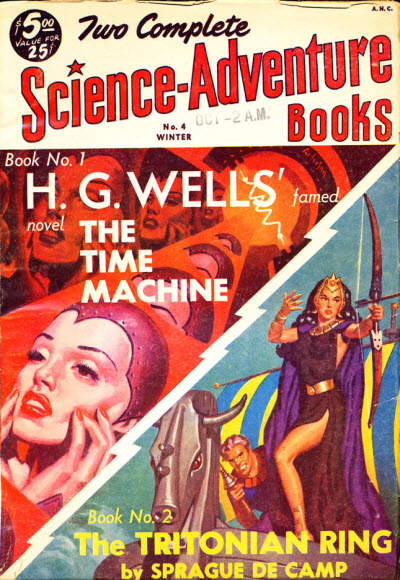Riding a Big Ball of Wibbly Wobbly*
by Kim Pederson…….
In his book Time Travel, author James Gleick provides, according to the jacket blurb, “a mind-bending exploration of time travel: its subversive origins, its evolution in literature and science, and its influence on our understanding of time itself.” I’m only into the first chapter so far, but Gleick seems to be living up to the blurbomise [book jacket promise of stellar content]. It all began, in literature at least, with H.G. Wells’ The Time Machine, as Gleick describes:
Our hero fiddles with some screws [on the time machine], adds a drop of oil, and plants himself on the saddle. He grasps a lever with both hands. He is going on a journey. And by the way so are we. When he throws that lever, time breaks loose from its moorings.

Wells, according to Gleick, “invented a new mode of thought” when he dreamed up the time machine. Then, in a later chapter, Gleick asks, “Can you, citizen of the twenty-first century, recall when you first heard of time travel?” He doubts it, given the massive infusion of chronotraipsing into our imaginative world since The Time Machine. Felix the Cat traveled in time. So did Elmer Fudd and, of course, Mr. Peabody and Sherman. The number of time travelers [chrononauts?] have been countless and will only grow, I’m sure. I read TTM who knows how long ago (I would need to chronotraipse myself to find out) but I couldn’t swear to it being my first exposure to time excursions.
All of the chrononautic adventurers have, well, adventures, scary and exciting for them and sometimes also for the readers. Si Morley, the main character in Jack Finney’s classic 1970 novel Time and Again, is one of my favorites. (Two others are Clare and Henry from The Time Traveler’s Wife.) In T&A (an unfortunate acronym) Morley is recruited into a secret Army project to save the world (naturally). He learns how to time travel using self-hypnosis. that is, with the help of movie sets and actors he is able to convince himself that he is in 1882 instead of 1970 and, voila, there he is! In the end [SPOILER ALERT!], he decides the time project is ill-conceived, perhaps even evil, and returns to 1882. There he stops the parents of the project head from meeting and, presto chango, no project. He stays in the past with the woman he met there and fell in love with and, presumably, they lived happily ever after. He also conveniently avoids witnessing or taking responsibility for any “collateral damage” in the future that may have come from his actions.
Anyway, we all experience time and the desire, occasional for some and obsessive for others, to slow it down or speed it up, travel at will to the past and/or future, or even merely wind our life clocks backward to answer all those pesky “what ifs.” We also have invented myriad clever ways to measure it and track it and remind us of how much of it we…okay me/I…waste, in this case while trying to figure it out if I can self-hypnotize and zip ahead three years or so. The fear in that, of course, is that, if I manage it, I will discover that Idiocracy has come to pass. If you haven’t seen the movie, it’s where we get dumber rather than smarter as time marches on and the United States becomes a place where “the English language had deteriorated into a hybrid of hillbilly, valley girl, inner-city slang and various grunts.” In the film, this degradation takes five hundred years. In the real world…well, I’m afraid to even think about it.
* PS: The title comes from someone who truly understands, or who truly understands that no one truly understands, what we call time: Doctor Who. As he puts it, “People assume that time is a strict progression of cause to effect, but actually from a nonlinear, nonsubjective point of view it’s more like a big ball of wibbly wobbly…timey wimey…stuff.” Brilliant!
~~~~~~~~~~
Visit Kim Pederson’s blog RatBlurt: Mostly Random Short-Attention-Span Musings.

